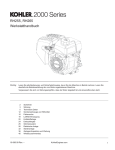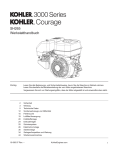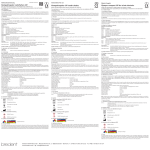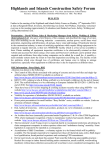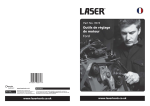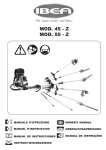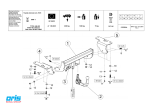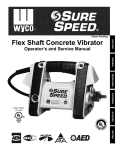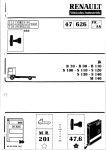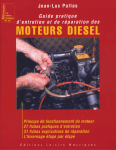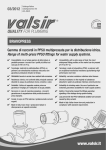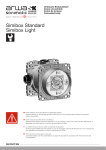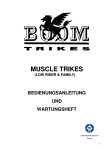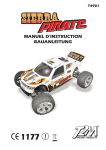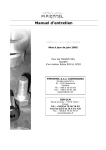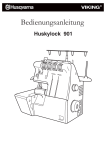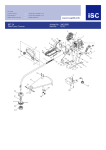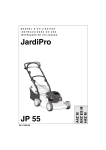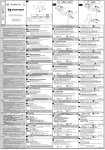Download maintenance manual
Transcript
MANUEL D’ENTRETIEN MANUEL D’ENTRETIEN MAINTENANCE MANUAL MAINTENANCE MANUAL X-T & X-Race TIGER X-T & X-Race TIGER A - ENTRETIEN PAR LE PILOTE A - ENTRETIEN PAR LE PILOTE MAINTENANCE BY THE PILOT MAINTENANCE BY THE PILOT Sécurités mécaniques - Mechanical safety Hélice- Propeller Cage- Cage Allumage - Ignition Démarreur électrique - Electric starter Batterie - Battery Courroie - Belt Silentblocs - Shock mounts Filtres - Filters Sécurités mécaniques - Mechanical safety Hélice- Propeller Cage- Cage Allumage - Ignition Démarreur électrique - Electric starter Batterie - Battery Courroie - Belt Silentblocs - Shock mounts Filtres - Filters B - COMMENT SE DEPANNER SEUL B - COMMENT SE DEPANNER SEUL HOW TO DO IT YOURSELF HOW TO DO IT YOURSELF Carburateur - Carburettor Allumage - Ignition Moteur - Engine Hélice - Propeller Réservoir - Fuel tank Informations techniques -Technical informations Carburateur - Carburettor Allumage - Ignition Moteur - Engine Hélice - Propeller Réservoir - Fuel tank Informations techniques -Technical informations C- PLANS ET REFERENCES C- PLANS ET REFERENCES Drawings and part numbers Drawings and part numbers 10/2010 10/2010 A - Anweisungen an den Piloten A - ENTRETIEN PAR LE PILOTE A - MAINTENANCE BY THE PILOT Mechanische Sicherheit Mechanical safety Les sécurités mécaniques Mechanical safety Alle Schrauben und Bolzen sind mit einem Gewindekleber, Mutter mit Klemmteil (Nylstop) oder speziellem Sicherungsteller befestigt. All screws and nuts are tightened with threadlocker, nyloc or specific washers. Toutes les vis sont bloquées à l’aide de frein filet, de nylstop ou de rondelles spécifiques. All screws and nuts are tightened with threadlocker, nyloc or specific washers. Carburettor The carburettor is fastened with two screws (SIM3100). The 2 screws are tightened with removable threadlocker. Carburateur Le carburateur est fixé par deux vis (SIM3100). Les deux vis sont collées avec du frein filet faible. Carburettor The carburettor is fastened with two screws (SIM3100). The 2 screws are tightened with removable threadlocker. Exhaust The exhaust pipe is fastened with two bolts (Si57) and two specific nuts. The exhaust is fastened with three shock mounts (Z12) which must be replaced as soon as they are worn; if not, it can damage the exhaust. The exhaust is adjusted on the exhaust pipe with a flexible (Si560C) and one spring (Cu4) which is secured by stainless thread. The silencer is fastened on the exhaust with one screw DEM11, one nut MC10 ; and with a collar SIM02_4. Echappement (SIM02) La fixation de la pipe d’échappement se fait à l’aide de goujons (Si57) et d’écrous spécifiques (fendus). Le mégaphone est maintenu par 3 silent blocs (Z12) qui doivent être remplacés dès les premiers signes d’usure, au risque de dégrader le pot d’échappement. Ce mégaphone est relié à la pipe d’échappement par 1 flexible et 1 ressort (Cu4) qui est assuré par du fil inox. La cartouche est elle serrée sur l’échappement par une vis DEM11 et son écrou MC et maitenue par un collier SIM02_4. Exhaust The exhaust pipe is fastened with two bolts (Si57) and two specific nuts. The exhaust is fastened with three shock mounts (Z12) which must be replaced as soon as they are worn; if not, it can damage the exhaust. The exhaust is adjusted on the exhaust pipe with a flexible (Si560C) and one spring (Cu4) which is secured by stainless thread. The silencer is fastened on the exhaust with one screw DEM11, one nut MC10 ; and with a collar SIM02_4. Vergaser Der Vergaser ist mit 2 selbstsichernden Schrauben (SIM3100. Die Schrauben sind mit einem speziellen Sicherungsteller befestigt. Auspuff (SIM02) Der Auspuff ist mit zwei Stehbolzen (Si57) und mit selbstsichernden Muttern am Zylinder verschraubt. Der Auspuff (Megaphon) wird mit einer Zugfeder (Z12) gehalten. Diese muß sofort nach kleinsten Zeichen der Abnutzung ausgetauscht werden. Der Auspuff ist durch ein Flexrohr (Si560C) und einer Feder (Cu4), welche durch einen rostfreien Sicherheitsdraht versehen ist, am Flansch (SIM02/01)befestigt. Der Schalldämpfer ist am Aufpuff mit Schraube (DEM11), einer Mutter (MC10) sowie mit einer Schelle (SUM02_4) Kontrollieren sie regelmäßig das Flexrohr auf festen Sitz. Zum Abdichten beidseitig mit Dichtungspaste versehen. Alle 100 Flugstunden muß das Flexrohr ausgetauscht werden.. Antrieb/Übersetzung Die Schrauben der Propellerbolzen (MR14 ) sind eingeklebt und mit Selbstsichernden Schrauben(MR26) versehen, nur diese dürfen verwendet werden. Achtung: Bei jedem Start-Check überprüfen Sie die Markierung auf der Befestigungsschraube MR26 der Riemenscheibe! Die Kugellager (MR22) der Riemenscheibe sind eingepresst und mit einer Loctide Befestigungsmasse gesichert. Diese müssen bei jeder Beschädigung des Propellers oder wenn Flüssigkeit austritt gewechselt werden. Check the flexible (SI560C) often. To avoid leakage, put silicone paste on both sides. Contrôler régulièrement le flexible. Pour éviter les fuites, placer de la pâte à joint silicone de part et d’autre du flexible. Every 100 hours : change the silencer if necessary. Toutes les 100 h, changer la cartouche si elle ne remplit plus son office de silencieux. Check the flexible (SI560C) often. To avoid leakage, put silicone paste on both sides. Every 100 hours : change the silencer if necessary. Reduction gear It is assembled with screws and nuts. Only the propellers bolts (MR14) and the screw (Mr26) are tightened with removable threadlocker. Réduction Toute la réduction est assemblée par des vis et nylstops. Seuls les goujons d’hélice (MR14) et la vis (MR26) sont montés au frein filet faible. Reduction gear It is assembled with screws and nuts. Only the propellers bolts (MR14) and the screw (Mr26) are tightened with removable threadlocker. Warning : during each pre-flight check, verify the mark on the screw MR26 holding the propeller pulley ! Attention au témoin de marquage de la vis MR26 qui maintient la poulie porte hélice : le vérifier à chaque prévol ! Warning : during each pre-flight check, verify the mark on the screw MR26 holding the propeller pulley ! The bearings (MR22) of the pulley are adjusted in the pulley with a press and tightened with Loctite retaining. They must be changed if any major damage on the propeller occurs or if lubricant pours out. Les roulements (MR22) de la poulie sont montés à la presse dans la poulie et collés avec du scelroulement ; il faut les changer en cas de bris d’hélice important ou lors d’apparition abondante de graisse à l’extérieur. The bearings (MR22) of the pulley are adjusted in the pulley with a press and tightened with Loctite retaining. They must be changed if any major damage on the propeller occurs or if lubricant pours out. Propeller L’hélice Propeller The propeller is located between the two MR10 plates. L’hélice vient se positionner entre les deux contreplaques MR10. The propeller is located between the two MR10 plates. Propeller Der Propeller ist zwischen 2 Gegenplatten MR10 verschraubt. 2 A - MAINTENANCE BY THE PILOT 2 Holz : Anzugsdrehmoment 1.5 m.kg Wenn Lack am Propeller abplatzt wird durch das Holz Feuchtigkeit aufgesaugt, welche eine Unwucht verursacht. Warten sie nicht mit der Ausbesserung durch Acryllack. Wenn der Propeller noch nicht ausgebaut wurde überprüfen sie die Befestigung während des Start-Checks da sich das Holz verziehen kann. Gebrochene Bolzen am Propeller während des Fluges, können Unfälle / Schäden verursachen. Carbon : Anzugsdrehmoment 2.0 m.kg Die Wartung dieser Version ist einfacher, jedoch ist das Auswuchten komplizierter. Von großen asymetrischen Reparaturen ist abzusehen. Fest anziehen und prüfen sie die Festigkeit vor jedem Flug wenn sie den Propeller nicht abbauen. Der Käfig Netz Prüfen sie immer das Netz (XC4, 3 oder 2)und die Spannung des Netzes. Ist es lose oder Beschädigt, fixieren sie es mit den X39Schnüren oder tauschen sie es aus. .Bei montierter Lagerung lösen sie die Spannung der X39 Schnüre um die XC10 Teile. Beachten Sie auch den Haken und die Nieten. Fehlt eine Niete können sie das Netz während des Fluges verlieren. Rohre Kontrollieren sie die Steckverbindungen. Plastikteile Kontrollieren sie diese regelmäßig. Die Halterung am Chassis muß korrekt befestigt sein. Um diese Auszutauschen, drehen sie beide Nieten und tauschen sie die Teile. Befestigen sie eine neue Halterung mit Expodykleber (ex. Araldite) und Nieten. Zündung Erdung Die Erde am Ein/Aus-Schalter und am Notaus (Handgas) ist unterschiedlich um ein Ausschaltung zu gewährleisten, wenn einer der Schalter defekt ist. Anschlüsse Die gesamte Elektronischeanschlusstechnik ist verlötet, und muss im Falle einer Reparatur oder Demontage neu verlötet werden . Wood : tightening 1.5 m.kg If varnish has been removed on the propeller, the wood absorbs humidity that unbalances it. Do not delay in repairing it with a spray of acrylic varnish. Bois : serrage 1.5 m.kg Si l’hélice a perdu son vernis suite à de petits accrocs, le bois absorbe de l’humidité ce qui déséquilibre l’hélice . Il est vivement conseillé de revernir ces endroits sans tarder avec du vernis acrylique en bombe. De plus, si l’hélice n’est pas démontée, bien vérifier le serrage à la prévol ; le bois travaille et une hélice bien serrée ne l’est pas forcément le lendemain. Un bris des goujons et de l’hélice en l’air entraînerait des dommages matériels importants. If the propeller has never been disassembled, verify the tightening during the pre-flight check as wood shrinks. If bolts or the propeller break in the air, the damages may be very important. Composite : tightening 2.0 m/kg The maintenance of this propeller is easier but the balance is more difficult. Do not make too important unsymmetrical repair. Tighten firmly and if you do not disassemble the propeller, check its tightening before each flight. Composite : serrage 2.0 m.kg L’entretien de cette hélice est plus facile mais son équilibrage est délicat. Ne pas effectuer de réparation dissymétrique trop importante. Serrer fermement et, si votre hélice reste montée, contrôler son serrage avant chaque vol. Cage La cage Net Always control the net (XC4, 3 or 2) and the tension. If it is untight or damaged, tight it more by the X39 lines or change it. In case of a stored engine assembly, release the tension by the X39 line around the XC10 parts. Take care also to the hook and rivet. If any rivet is missing, you could loose your net in flight. Filet Toujours vérifier l’état du filet (XC4,3 ou2) et sa tension. S’il est usé à un endroit ou trop détendu, ne pas hésiter à le resserrer par l’intermédiaire des deux suspentes de tension X39. Il est conseillé dans le cas d’un stockage monté de détendre la seconde suspente (la sortir de ces tendeurs XC10). Attention au agraffes et rivets. Tout rivet manquant pourrait engendrer la perte du filet en vol. Tubes Control the luggs in the plastic parts. Plastic parts Control them as regular as possible. The insert of the body need to be correctly fixed. To change them, drill the 2 breaking rivet, dissasemble the parts, and assemble a new one with epoxy glue (ex. Araldite) and rivet. Ignition 3 3 Composite : tightening 2.0 m/kg The maintenance of this propeller is easier but the balance is more difficult. Do not make too important unsymmetrical repair. Tighten firmly and if you do not disassemble the propeller, check its tightening before each flight. Cage Net Always control the net (XC4, 3 or 2) and the tension. If it is untight or damaged, tight it more by the X39 lines or changed it. In case of a stored engine assembly, release the tension by the X39 line around the XC10 parts. Take care also to the hook and rivet. If any rivet is missing, you could loose your net in flight. Tubes Control the luggs in the plastic parts. Pièces plastiques Contrôler régulièrement leur état. Les inserts dans la coque ne doivent pas bouger. Pour les changer, retirer les rivets, démonter la pièce et remonter une pièce neuve en la recollant avec de la résine époxy (ex. araldite). Plastic parts Control them as regular as possible. The insert of the body need to be correctly fixed. To change them, drill the 2 breaking rivet, dissasemble the parts, and assemble a new one with epoxy glue (ex. Araldite) and rivet. L’allumage Ignition Connectiques Toutes les connectiques sont soudées et doivent être ressoudées en cas de réparation ou démontage. Connectors All the connectors are welded and must remain welded after any dissassembly or repair. If the propeller has never been disassembled, verify the tightening during the pre-flight check as wood shrinks. If bolts or the propeller break in the air, the damages may be very important. Tubes Contrôler les emboîtements avec les pièces plastiques. Masse Les masses de l’interrupteur ON/OFF et de l’interrupteur coupe circuit de la poignée de gaz sont différentes afin de pouvoir couper le moteur en cas de panne d’un des deux interrupteurs. Earth The earth of the on/off and on the cutoff interruptors (hand throttle) is different in order to switch off the engine off even if one of the interruptor is defective. Wood : tightening 1.5 m.kg If varnish has been removed on the propeller, the wood absorbs humidity that unbalances it. Do not delay in repairing it with a spray of acrylic varnish. Earth The earth of the on/off and on the cutoff interruptors (hand throttle) is different in order to switch off the engine off even if one of the interruptor is defective. Connectors All the connectors are welded and must remain welded after any dissassembly or Zündzeitpunkt Magnethub: Die Verkeilung muss sich zwischen 2/10 u.8/10 befinden ( Stellung zwischen den Magneten) Diese muss symmetrisch sein . Ignition settings . Ignition gap (between coil’s head and magnet) : the adjustment is located between 2/10e and 8/10e and must be symetrical Calage de l’allumage . Entrefer : Le calage doit être entre 2/10e et 8/10e (espace entre les deux fers de la bobine et chaque aimant du volant magnétique). Il doit etre symétrique. Elektrostarter Regelmäßig die mechanischen Teile überprüfen: - Zustand der Transportzähne /Krone - Den Anlasser auf seine Befestigung - Elektronische Anschlüsse Kabel. Etc. Sollte der Anlasser den Motor bei der Verdichtung nicht drehen, Versuchen sie es nicht weiter ACHTUNG der Anlasser könnte beschädigt werden! Drücken sie mehrmals den Startknopf. Wen das nicht funktioniert überprüfen sie die Batterie und die Verdichtung. Ist diese sehr hoch, überprüfen sie den automatischen Dekompressor, der sich im Zylinder befindet. Sollte es immer noch nicht funktionieren, kontaktieren sie ihren Verkäufer. . Démarreur électrique Electric starter Il faut surveiller régulièrement les organes mécaniques : état des dents de la couronne et du démarreur ainsi que la fixation du démarreur et de son support. Vérifier également le faisceau électrique (fil coupé ou chauffant anormalement,etc.) Si le démarreur ne passe pas la compression, ne pas insister sur l’interrupteur : le démarreur va chauffer et risque de s’endommager. Donner plusieurs impulsions sur le démarreur, si cela ne fonctionne pas, contrôler la batterie. Si elle est correcte, vérifier la compression. Si cette dernière est importante, vérifier le décompresseur automatique situé à l’arrière du moteur. Si tout ceci n’y fait rien, consultez votre revendeur qui testera votre démarreur. Mechanical parts must be regularly controlled : teeth of the electric starter crown, starter itself and adjustement of the starter on its support. Check as well the electric bundle (cut wire or unusual overheating, etc.). If the starter does not start, do not insist : it will get heated and may be damaged. Push several times on the starter ; if it does not work, check the battery. If it is correct, check the compression. If it is very high, clean the integrated decompressor. If nothing happens, contact your retailer who will test the starter. Batterie Es wird eine L-Ion Batterie mit 14,8 V ( 2300mA) verwendet. Diese muss mit dem mitgelieferten Schnellladegerät für maximal 1,5 Stunden geladen werden. Die Entladung beträgt 10% pro Jahr. Die Batterie sollte bei Einlagerung zwischen 25% und 75% geladen sein. Ladespannung unter 15V. BATTERIE NICHT ÖFFNEN UND STROMSCHLÄGE VERMEIDEN. Achtung : Eine vollständig geladene Batterie hat eine Spannung von über 17V. Unter 15V dreht der Anlasser aber zu langsam um zu zünden. Antriebsriemen Kontrolle der Spannung Bewegen sie den Antriebsriemen in der Mitte der beiden Zahnriemenscheiben, der weg darf nicht mehr als 5 mm und nicht weniger als 2 mm sein . Batterie Battery La batterie est une batterie Lithium Ion de 14,8 V (2300 mA) : la recharger avec le chargeur (intelligent) spécifique joint (il délivre 1800mA, la batterie sera chargée en 1 heure et demie). La LED basculera du rouge au vert une fois la batterie chargée. The Lithium Ion 14.8 V battery (2300 mA) :must be charged only with the supplied fast and intelligent charger in a macximum of 1 hour and half.. 10% of discharge in one year. This battery should be between 25 and 75% of full charge when stored for a long period of time. Charge the battery under 15V. 10% de décharge en 1 an. La batterie doit être chargée entre 25% et 75% de la pleine charge lors d’un stockage prolongé. Charger la batterie qua cette dernière atteint 15.0V. NE PAS OUVRIR LA BATTERIE ET LA PROTEGER DES CHOCS Attention : une batterie chargée dépasse les 17.0 V en tension. En dessous de 15.0V, le moteur passera la compression mais ne tournera pas assez vite pour effectuer une étincelle et démarrer ce dernier. DON’T OPEN THE BATTERY AND AVOID SHOCK ON IT. Warning : a full charged battery has a tension over 17.0 V. Under 15.0V, the engine can pass the compression., but it doesn’t turn fastly enough to create the spark and start. Belt Courroie Control of the tension Between the two pulleys, press a rule on the whole width of the belt : the rule should not sink more than 5 mm and not less than 2 mm. 4 Contrôle de la tension A mi-chemin entre les deux poulies, appuyer avec une règle sur toute la largeur de la courroie : la règle ne doit pas s’enfoncer de plus de 5 mm et pas moins de 2 mm. 4 Ignition settings . Ignition gap (between coil’s head and magnet) : the adjustment is located between 2/10e and 8/10e and must be symetrical. Electric starter Mechanical parts must be regularly controlled : teeth of the electric starter crown, starter itself and adjustement of the starter on its support. Check as well the electric bundle (cut wire or unusual overheating, etc.). If the starter does not start, do not insist : it will get heated and may be damaged. Push several times on the starter ; if it does not work, check the battery. If it is correct, check the compression. If it is very high, clean the integrated decompressor. If nothing happens, contact your retailer who will test the starter. Battery The Lithium Ion 14.8 V battery (2300 mA) :must be charged only with the supplied fast and intelligent charger in a macximum of 1 hour and half.. 10% of discharge in one year. This battery should be between 25 and 75% of full charge when stored for a long period of time. Charge the battery under 15V. DON’T OPEN THE BATTERY AND AVOID SHOCK ON IT. Warning : a full charged battery has a tension over 17.0 V. Under 15.0V, the engine can pass the compression., but it doesn’t turn fastly enough to create the spark and start. Belt Control of the tension Between the two pulleys, press a rule on the whole width of the belt : the rule should not sink more than 5 mm and not less than 2 mm. Wechsel des Antriebsriemens Lösen sie die M8 Schraube (MR24) an der Untersetzung. Drehen sie mit einem Schraubenschlüsseldrehen den Exzenterbolzen der Untersetzungsscheibe durch den Intermediär d e r Zentralschraube (MR 26) ab. Wechseln sie den Antriebsriemen und passen sie die Spannung mit der Zentralschraube (MR26) an. Ziehen sie die M8 Schraube (M24) an um den Wechsel abzuschließen. Durch Vibrationen kann nach der Einlaufphase die Spannung abfallen. Erzeugt der Riemen ein schrilles Geräusch bei niedrieger Drehzahl prüfen sie die Spannung und wechseln sie den Riemen ggf. aus. Change of the belt Untight the M8 bolt (MR24) which hold the reduction support. Turn the main shaft with a key on the central screw (MR26). Change the drive belt and adjust the belt tension clockwise with the central screw (MR26) to adjust the belt tension. Tighten the bolt MR24 to finish the operation. Riemenspannung anpassen Ändern sie die Spannung mit der Schraube MR26 um ein Durchdrehen bei Vollgas zu verhindern. Anmerkung : Ein gut angezogener Antriebsriemen ermöglicht eine geringe Vibration während des Fluges. Ein zu sehr angezogener Antriebsriemen beansprucht die Achsen und Radlager dies kann zu Schäden am Lager und Zahnriemenscheibe führen. Einstellung der Riemenscheiben Wenn die Untersetzung ausgebaut wurde, müssen die Riemenscheiben korrekt eingestellt werden, um eine Dehnung des Riemens zu verhindern. Benutzen sie ein Lineal an der Riemenscheibe (SIM3336A) und passen sie die Untersetzung (SIM3265) an. Vibrationsdämpfer Die Vibrationsdämpfer müssen alle 50 Betriebsstunden oder jedes Jahr ausgetauscht werden. Bei jedem Start-Check ist eine Kontrolle erforderlich. Filter Benzinfilter : Der Benzinfilter muss regelmäßig mit Benzin gereinigt werden. Den ersten Filter finden sie an der Kraftstoffleitung unmittelbar vor dem Vergaser. Prüfen Sie daß, das Filterpapier nicht lose ist und tauschen sie es ggf. aus. Ein zweiter Filter befindet sich im Vergaser. Schrauben sie hierfür die vier Schrauben am Vergaser heraus. Sie sehen ein rundes Netz unter der Membrane. Lösen sie jedweden Schmutz auf dem Netz um den Sprifluss zu gewährleisten. 5 Changement de la courroie Desserrer l’écrou supérieur (MR24) serrant le support réducteur en haut. Prendre une clé et faire tourner l’arbre (excentrique) de la poulie de réduction par l’intermédiaire de la vis centrale (MR26). Mettre la poulie en position basse et sortir la courroie. La changer et la retendre par la vis MR26 dans le sens horaire. Enfin, resserrer la réduction de l’écrou MR24. La courroie est susceptible d’être changée après le rodage à cause des vibrations et des à-coups dûs au moteur non rodé. Si la courroie produit un bruit strident à bas régime, vérifier la carburation et la courroie est à changer si elle est usée. Change of the belt Untight the M8 bolt (MR24) which hold the reduction support. Turn the main shaft with a key on the central screw (MR26). Change the drive belt and adjust the belt tension clockwise with the central screw (MR26) to adjust the belt tension. Tighten the bolt MR24 to finish the operation. Tension adjustment Adjust the tension with the bolt MR26 to avoid the belt leap when engine is at full gas. Réglage de la tension Tendre la courroie (mais pas trop) pour éviter qu’elle patine (moteur à fond) par la vis MR26. Tension adjustment Adjust the tension with the bolt MR26 to avoid the belt leap when engine is at full gas. Note : if the belt is well ajusted, it does not slip nor leap and there are less vibrations. If it is too tight, it strains the axes and bearings and may even break in the air or damage the pulley or the reductor. Nota : une courroie bien tendue et alignée flape peu, ne patine pas et ne saute pas, donc moins de vibrations. Une courroie trop tendue fatigue les axes et roulements, peut entraîner la rupture de la poulie ou du réducteur ou se détruire en vol. Note : if the belt is well ajusted, it does not slip nor leap and there are less vibrations. If it is too tight, it strains the axes and bearings and may even break in the air or damage the pulley or the reductor. Alignement of the pulleys If the reduction has been disassembled, the pulleys must be aligned again to prevent a strain on the belt. Put a rule on the pulley (SIM3336A) and adjust the reduction with the main shaft (SIM3265). Alignement des poulies En cas de démontage de la réduction, il faut faire attention à l’alignement des poulies lors du remontage sinon la courroie pourra s’abîmer et se détruire en quelques heures. Pour cela, positionner un réglet sur la poulie porte hélice (SIM3336A) et ajuster la réduction en profondeur par son arbre (SIM3265). Alignement of the pulleys If the reduction has been disassembled, the pulleys must be aligned again to prevent a strain on the belt. Put a rule on the pulley (SIM3336A) and adjust the reduction with the main shaft (SIM3265). Silentblocs They must be changed every year or after 50 hours flight and controlled during each preflight check. The belt may be changed after the running-in because of the vibrations during that time. If the belt makes a shrill noise at low rating, check the carburation and change the belt if necessary. Shock mounts They must be changed every year or after 50 hours flight and controlled during each preflight check. Les silent-blocs sont des pièces d’usure ; ils doivent être changés tous les ans ou toutes les 50 heures et contrôlés à chaque prévol. Filters Filtres Fuel filters They must be regularly cleared (with fuel). The first one (paper) is located on the fuel pipe, before the carburettor. Check that the inside paper is not loose, otherwise replace it and control the second filter (inside the carburettor). Disassemble the plate on the carburettor (4 screws). You will see a round netting under the membrane. Clear all the dust on the round screen to allow fuel to come in. A essence : Les filtres à essence doivent être nettoyés régulièrement à l’essence. Le premier (papier)se situe sur le circuit d’alimentation d’essence avant le carburateur. Vérifier que le papier intérieur ne soit pas décollé de son socle auquel cas le remplacer et contrôler le second filtre (intégré au carburateur). Démonter la plaquette dessous le carburateur (4 vis côté hélice). Vous apercevrez une grille ronde sous la membrane. Retirer les résidus sur cette grille. 5 The belt may be changed after the running-in because of the vibrations during that time. If the belt makes a shrill noise at low rating, check the carburation and change the belt if necessary. Shock mounts Filters Fuel filters They must be regularly cleared (with fuel). The first one (paper) is located on the fuel pipe, before the carburettor. Check that the inside paper is not loose, otherwise replace it and control the second filter (inside the carburettor). Disassemble the plate on the carburettor (4 screws). You will see a round netting under the membrane. Clear all the dust on the round screen to allow fuel to come in. Luftfilter (SIM3201) Überprüfen Sie den Luftfilter ( Z12) auf festen Sitz hierbei die Gummilasche( R584) sowie die Schlauchschelle (R582). Wenn nötig tauschen sie den Schalldämpfer (Silent-Bloc) aus. . Air filter : Inlet silencer (SIM3201) Check the rubber pipe (R584) which holds the inlet silencer to the carburettor, the tightening of the collar (R582) and the shock mount (Z12) on the top of the inlet silencer. Change the shock mount or the rubber pipe if neccessary. A air : le silencieux d’admission (SIM3201) Vérifier la bride caoutchouc (R584) maintenant la boite à air au carburateur, le serrage du collier (R582), ainsi que la fixation sur silent bloc (Z12) du haut du silencieux. Au besoin, changer le silent bloc ou la bride caoutchouc. B - WIE HELFE ICH MIR SELBST? B - HOW TO DO IT YOURSELF B - COMMENT SE DEPANNER SEUL B - HOW TO DO IT YOURSELF Vergaser : WALBRO Carburettor : WALBRO Carburateur : WALBRO Membranensatz : REF W350800 Membranes kit : P/N W350800 Kit membrane : référence W350800 Carburettor : WALBRO The motor is flooded Take off the spark plug, turn several times the propeller with the hand. Dry the spark plug and adjust it. If the motor keeps on flooding, disassemble the carburettor to clean the needle, and check the membrane. Disassemble the plate with the priming button, remove the membrane and its gasket, check it. Untighten the screw holding the fork axle (mind the spring below). Take out the needle, and clean it by rubbing it until it becomes red. Blow air inside the carburettor, and reassemble the whole. Le moteur est noyé Démonter la bougie, faire tourner manuellement le moteur par l’hélice sur quelques tours. Sécher la bougie et la remonter. Si le moteur continue à se noyer, démonter le carburateur pour nettoyer le pointeau et contrôler la membrane. Démonter la plaque comportant le poussoir nécessaire à l’amorçage, retirer la membrane et son joint, la contrôler. Desserrer la vis maintenant l’axe de la fourchette (attention au ressort situé dessous). Sortir le pointeau et nettoyer la tête de pointeau en la frottant (elle doit devenir rouge). Souffler à l’intérieur du carburateur, sur la portée du pointeau. Remonter le tout. Ne jamais tordre la fourchette ni essayer de tirer ou de compresser le ressort ! Membranes kit : P/N W350800 Der Motor ist geflutet .Entfernen sie die Zündkerze, und drehen den Propeller mehrmals in Drehrichtung. Danach die Kerze wieder einschrauben. Sollte der Motor danach immer noch absaufen, bauen sie den Vergaser aus reinigen die Vergasernadel und überprüfen die Membrane. Hierzu entfernen sie die Schwimmerplatte mit der Achsgabel entfernen die Düsennadel und reinigen dies ( Spitze rot ) mit etwas Luft den Vergaser ausblasen, und anschließend wieder einbauen . ACHTUNG Nicht die Achsgabel verbiegen ! Der ist abgesoffen Lösen Sie die Schraube „H“, um die Maximaldrehzahl zu erreichen. Seien Sie vorsichtig, mit dieser Einstellung zu fliegen, da sich der Motor festfressen könnte. . Wenn der Motor bei mittlerer Drehzahl unregelmäßig läuft Der Vergaser ist zu fett eingestellt; regeln sie ihn auf eine weniger fette Einstellung indem sie den Knopf „L“ im Uhrzeigersinn um jeweils „fünf Minuten“ verstellen, bis der Motor wieder sauber läuft. Prüfen sie danach die Laufeigenschaft bei Vollgas und im Leerlauf. Wenn sich keine Verbesserung einstellt, nehmen sie eine vollständige Neueinstellung des Motors vor. Wenn der Motor abstirbt Der Kraftstoff kommt kaum beim Motor an, der Motor springt an und stirbt danach ab... Nehmen Sie die obere Abdeckung des Vergasers ab und kontrollieren Sie die darunter liegende Membrane. Jeder auch noch so kleine Tropfen kann das ordentliche Ansaugen durch den Motor verhindern . 6 Air filter : Inlet silencer (SIM3201) Check the rubber pipe (R584) which holds the inlet silencer to the carburettor, the tightening of the collar (R582) and the shock mount (Z12) on the top of the inlet silencer. Change the shock mount or the rubber pipe if neccessary. Never torque the fork, nor try to pull or press the spring ! The motor gets clogged Untighten the H screw to have the maxi RPM. Be carefull, if you fly with this fact, you will seize the engine. Le moteur s’engorge à fond Desserrer la vis H pour récupérer le régime maxi. Attention, si vous volez avec ce symptome vous risquer de serrer le moteur. The engine runs erratically at mid speed (RPM) The carburettor is set too rich; adjust to a leaner position by turning knob « L » clockwise of 5 mn, and again until the engine runs nicely. Then check at full speed and idle. If any change, do a complete setting. Le moteur "ratatouille" à mi régime La carburation est trop riche ; resserrer la vis de réglage L de 5 minutes. Recommencer l’opération jusqu’à ce que le moteur tourne bien. Vérifier ensuite le fonctionnement à fond et au ralenti. Si cela ne suffit pas, refaites un réglage complet. The engine stalls The fuel comes hardly to the engine by the main fuel line, the engine starts, and stalls… Disassemble the upper plate of the carburettor, and control the membrane under it. Any tear, even very small, will prevent the engine to prime. Le moteur ne prend pas ses tours et cale L’essence a du mal à monter dans la durite d’arrivée d’essence, le moteur démarre et cale aussitôt… l’étage de pompe du carburateur est défectueux. Démonter la plaque supérieure du carburateur et contrôler la membrane située en dessous. La moindre déchirure, si infime soitelle, provoquera un désamorçage instantané du moteur. 6 The motor is flooded Take off the spark plug, turn several times the propeller with the hand. Dry the spark plug and adjust it. If the motor keeps on flooding, disassemble the carburettor to clean the needle, and check the membrane. Disassemble the plate with the priming button, remove the membrane and its gasket, check it. Untighten the screw holding the fork axle (mind the spring below). Take out the needle, and clean it by rubbing it until it becomes red. Blow air inside the carburettor, and re-assemble the whole. Never torque the fork, nor try to pull or press the spring ! The motor gets clogged Untighten the H screw to have the maxi RPM. Be carefull, if you fly with this fact, you will seize the engine. The engine runs erratically at mid speed (RPM) The carburettor is set too rich; adjust to a leaner position by turning knob « L » clockwise of 5 mn, and again until the engine runs nicely. Then check at full speed and idle. If any change, do a complete setting. The engine stalls The fuel comes hardly to the engine by the main fuel line, the engine starts, and stalls… Disassemble the upper plate of the carburettor, and control the membrane under it. Any tear, even very small, will prevent the engine to prime. Wie man den Vergaser einstellt HOW TO ADJUST THE CARBURETTOR COMMENT AJUSTER LE CARBURATEUR HOW TO ADJUST THE CARBURETTOR Ziehen Sie die Schraube „L“ vollständig an und lösen Sie diese danach um ½ Drehung. Ziehen Sie die Schraube „H“ vollständig an und lösen Sie diese danach um eine ¾ Drehung L H Tighten thoroughly L screw and untighten 1/2 turn Tighten thoroughly H screw and untighten 7/8 turn Serrer à fond la vis L et desserrer de 1/2 tour Serrer à fond la vis H et desserrer de 7/8 tour L H Tighten thoroughly L screw and untighten 1/2 turn Tighten thoroughly H screw and untighten 7/8 turn 1/2 0 0 7/8 Starten Sie dann den Motor. Wenn der Motor danach im Leerlauf unsauber läuft, ziehen Sie die Schraube „L“ langsam wieder an (aber nicht unter 3/8). Wenn beim Gasgeben Probleme mit dem Motor auftreten, lösen Sie die Schraube „L“ weiter. Das gleiche gilt für den Fall, dass der Motor bei jedem Start schlecht anspringt. Lassen Sie den Motor danach bei Vollgas laufen und ziehen Sie die Schraube „H“ dabei an, bis der Motor an Drehzahl verliert. Lösen Sie dann die Schraube „H“ um etwa 1/8 bis ¼ Umdrehung, vergleichen mit der vorangegangenen Stellung. Stellen Sie die Schraube nie unter 5/8. Sollte die Einstellung immer noch keine Verbesserung gebracht haben, reinigen Sie bitte den Vergaser wie nachfolgend beschrieben und stellen Sie den Vergaser danach erneut ein . Warnung: wenn die Schraube „H“ zu weit angezogen wird, kann ihr Motor bei Vollgas absaufen und blockieren ! Wie man den Vergaser reinigt Vergasernadel: siehe „abgesoffener Motor“ Filter: siehe „Kraftstofffilter“ Für das schnelle Reinigen die Schraube „H“ voll anziehen und Schraube „L“ komplett lösen. Jetzt mit dem Startvorgang beginnen, um Kraftstoff über die Vergaserdüse „L“ anzusaugen. 2 oder 3 Mal wiederholen, dann die Schraube „L“ komplett anziehen und anschließend die Schraube „H“ lösen und den Vorgang entsprechend wiederholen. Danach die Schraube „H“ wieder anziehen und den Vergaser erneut einstellen . Zündung Die Zündung scheint nicht in Ordnung zu sein Der Motor startet nicht, obwohl der Starter arbeitet: Überprüfen Sie die Zündkerze und den Zündkerzenstecker. Lösen Sie die Verbindung des blauen Kabelbundes von der Handschubeinheit (SIM 3107), und versuchen Sie es erneut. Stellen Sie sicher, dass der Ausschalter 7 1/2 1/2 0 L 0 0 1/2 0 H 7/8 Démarrer le moteur. Si le moteur ratatouille au ralenti, resserrer très légèrement la vis L. Resserrez plusieurs fois si nécessaire (ne pas aller en dessous de 3/8) Si le moteur n’a pas une accélération franche ouvrir la vis L. De même si les redémarrages nécessitent des amorçages systématiques. Ensuite, mettre le moteur à fond et resserrer la vis H jusqu’à ce que le moteur perde des tours. Desserrer ensuite la vis H de 1/8 à 1/4 tour par rapport à cette position. Ne jamais descendre en dessous de 3/4. 7/8 Start the engine. If the engine runs erratically at idle, tighten little by little the L screw (never set under 3/8). If the engine has trouble in acceleration open the L screw. Do the same if you need to prime at each start. Then put the engine at full gaz and tighten the H screw until the engine looses Rpm. Untighten the H screw by 1/8 to 1/4 turn compared with the former position. Never adjust under 3/4. Si vous n’arrivez pas à faire un réglage correcte, nettoyer le carburateur comme indiqué ci-dessous et recommencer. If the adjustment is still not correct, please clean the carburettor as described below and start the adjustment operation again. Attention : si la vis H est trop serrée, il y aura un engorgement du moteur à fond et vous risquez de serrer le moteur ! Warning : if the H srew is too tightened, your engine will get clogged at full gaz and the engine may seize ! Comment nettoyer le carburateur ? Nettoyage pointeau : voir « moteur noyé » Nettoyage grille : voir filtre essence. How to clean the carburettor Needle : cf « flooded motor » Screen : cf « fuel filter » Pour un nettoyage rapide, serrer la vis H à fond et démonter la vis L complètement. Ensuite, amorcer par la petite poire pour faire couler l’essence par le gicleur L. Poirer 2 ou 3 fois, remonter L, serrer la à fond. Démonter maitenant la vis H et poirer à nouveau. L’essence coulera par le gicleur H. Remonter la vis et refaire le réglage des deux vis. For fast cleaning, tighten completly H screw and untighten the L screw completely. Prime to let the fuel pour from the idling jet L. Prime 2 or 3 times, assemble L and tighten thoroughly. Dissassemble H and prime as before. Fuel pours from jet H. Assemle H and adjust L and H. Ignition L’allumage The ignition seems wrong L’allumage semble défectueux Le moteur ne démarre plus, le démarreur s’enclenche, il n’y a pas d’étincelle : contrôler la bougie et le capuchon de bougie. Débrancher la cosse bleue fixée au support poignée de gaz (SIM3107) et réessayer. Vérifier que l’interrupteur coupe-circuit de la poignée de gaz n’est pas resté enfoncé. Controler également le voltage de la batterie (>16.0). The engine does not start, the starter engages, but there is no spark : check the spark plug and its cap. Disconnect the blue cable terminal fixed on the hand throttle support (SIM3107), and retest. Check that the cut off button on the hand throttle does not remain in a pushed position. Control also the voltage of the battery(>16.0V). 7 0 0 7/8 L H Start the engine. If the engine runs erratically at idle, tighten little by little the L screw (never set under 3/8). If the engine has trouble in acceleration open the L screw. Do the same if you need to prime at each start. Then put the engine at full gaz and tighten the H screw until the engine looses Rpm. Untighten the H screw by 1/8 to 1/4 turn compared with the former position. Never adjust under 3/4. If the adjustment is still not correct, please clean the carburettor as described below and start the adjustment operation again. Warning : if the H srew is too tightened, your engine will get clogged at full gaz and the engine may seize ! How to clean the carburettor Needle : cf « flooded motor » Screen : cf « fuel filter » For fast cleaning, tighten completly H screw and untighten the L screw completely. Prime to let the fuel pour from the idling jet L. Prime 2 or 3 times, assemble L and tighten thoroughly. Dissassemble H and prime as before. Fuel pours from jet H. Assemle H and adjust L and H. Ignition The ignition seems wrong The engine does not start, the starter engages, but there is no spark : check the spark plug and its cap. Disconnect the blue cable terminal fixed on the hand throttle support (SIM3107), and re-test. Check that the cut off button on the hand throttle does not remain in a pushed position. Control also the voltage of the battery (>16.0V). Sollte der Motor immer noch nicht starten, überprüfen Sie den Zündabstand. Ersetzen Sie danach die Zündspule. Der Starter arbeitet nicht mehr Der Hauptschalter steht auf ON und die Batterie ist angeschlossen, aber wenn Sie den Startknopf drücken: passiert nichts, außer ein „Klick-Klick“ des Relais: Überprüfen Sie die Haupterdung der elektrischen Installation (Kabelbund oberhalb der Getriebebox). Überprüfen Sie korrekten Anschluß des Kabelstranges am Starter. Ein oder mehrere Kabel könnten gebrochen oder der Kabelbaum falsch angeschlossen sein. passiert nichts und Sie hören auch nichts: überprüfen Sie die Verbindung Batterie/ Kabelbaum und Hauptschalter ON/OFF der Starter scheint zu arbeiten, kann den Kompressionspunkt des Motors jedoch nicht überwinden: Überprüfen Sie die Kompression des Motors (wenn nötig, reinigen Sie die Dekompressionseinrichtung). Überprüfen Sie die Antriebsriemenspannung. Sollte der Riemen durchrutschen, spannen Sie ihn. Überprüfen Sie die Batteriespannung (siehe Kapitel Batterie). Überprüfen Sie schließlich die Zähne des Zahnrades des Starters (SIM3200) und d e n Starterkopf (SIM3259). Sollte alles in Ordnung sein, der Motor aber dennoch nicht starten, wenden Sie sich bitte an Ihren nächsten Vertrieb. MOTOR Zu viel Kompression? SchlechtesStartverhalten ? Überprüfen Sie die Dekompressionseinrichtung des Tiger-Motors. Sie muss frei sein. Sie besteht aus einem 3 mm Loch schräg im Zylinder, aus dem während der Kompressionsphase der Überdruck entweichen kann. Zur Reinigung den Zylinderkopf abnehmen und mit einem 3 mm Bohrer das Dekompressionsloch schräg reinigen . Keine Kompression ? Die Kolbenringe oder Kolben könnten beschädigt sein. Entfernen Sie den Auspuff, um den Kolben 8 If it doesn’t work anyway, check the ignition gap (see before). Then change the coil. The starter does not work anymore : The main switch is on ON, and the battery connected, but when you push the starter button : - nothing happens but you hear « clic-clic » in the relay : Check the general earth of the electric bundle (cable terminal on the upper gear square of the reduction). Check the fixing of the wire connected to the starter. One or the other wire is broken or a cable terminal is not correctly connected. - nothing happens and you hear nothing : check the connection battery/electric bundle and the main switch ON/OFF. - the starter seems to work but cannot pass the compression point : Check the engine compression (clean the decompression hole if necessary). Check the belt tension. If it’s glide on the small pulley, tighten it. Check the battery voltage (refer to chapter concerning the battery). Finally, check the teeth of the starter (SIM3200) and the crown (SIM3259). If all is correct, contact your retailer. Engine Too much compression ? Difficult start ? You have to clear the integrated decompressor of the Tiger engine. It is made of a 3 mm hole slantwise in the cylinder out of which gases escape during the compression. If it is blocked, it leaves a visible mark. To clear it, take off the cylinder head, with a 3 mm drill, clear the hole slantwise in the cylinder. No more compression ? You may have stuck piston rings or even a seized motor. Disassemble the exhaust in order to check the piston. Si le phénomène persiste, vérifier le calage de l’allumage (voir précédemment). Enfin, changer la bobine. Le démarreur ne fonctionne plus Quand vous actionnez l’interrupteur démarreur avec l’inter général sur ON et la batterie connectée : Rien ne se passe mais vous entendez un "clic-clic" au niveau du relais : Vérifier la masse générale du faisceau électrique (cosse femelle fixée sur l’équerre supérieure de la réduction), vérifier la fixation du fil du démarreur : l’un ou l’autre fil est cassé ou a une cosse mal connectée, Rien ne se passe et vous n’entendez rien du tout : Vérifier votre liaison batterie/faisceau et votre interrupteur général. Le démarreur fait mine de démarrer mais ne passe pas la compression : Vérifier la compression du moteur (au besoin nettoyer le décompresseur). Vérifier la tension de la courroie afin que cette dernière ne patine pas sur la petite poulie (la retendre si besoin). Vérifier la batterie : se reporter au chapitre batterie. Il reste le démarreur : vérifier l’état des dents du démarreur (SIM3200) et de la couronne (SIM3259). Si tous les tests sont bons, rapprochez-vous de votre revendeur. MOTEUR Trop de compression ? Démarrage difficile ? Il est nécessaire de déboucher le décompresseur intégré du moteur Tiger. Il est constitué d’un trou de 3 mm qui part en biais dans le cylindre laissant échapper une partie des gaz lors de la compression vers l’échappement. S’il est bouché, il laisse une trace parfaitement visible. Pour le déboucher : déculasser le moteur, prendre un foret de 3 mm et, à la main, déboucher le trou qui part du cylindre vers l’échappement. Plus de compression ? Vous avez sûrement des segments gommés ou collés, voir un serrage. Démonter l’échappement et vous pouvez ainsi contrôler le piston. 8 If it doesn’t work anyway, check the ignition gap (see before). Then change the coil. The starter does not work anymore : The main switch is ON, and the battery connected, but when you push the starter button : - nothing happens but you hear « clic-clic » in the relay : Check the general earth of the electric bundle (cable terminal on the upper gear square of the reduction). Check the fixing of the wire connected to the starter. One or the other wire is broken or a cable terminal is not correctly connected. - nothing happens and you hear nothing : check the connection battery/electric bundle and the main switch ON/OFF. - the starter seems to work but cannot pass the compression point : Check the engine compression (clean the decompression hole if necessary). Check the belt tension. If it’s glide on the small pulley, tighten it. Check the battery voltage (refer to chapter concerning the battery). Finally, check the teeth of the starter (SIM3200) and the crown (SIM3259). If all is correct, contact your retailer. Engine Too much compression ? Difficult start ? You have to clear the integrated decompressor of the Tiger engine. It is composed of a 3 mm hole slantwise in the cylinder out of which gases escape during the compression. If it is blocked, it leaves a visible mark. To clear it, take off the cylinder head, with a 3 mm drill, clear the hole slantwise in the cylinder. No more compression ? You may have stuck piston rings or even a seized motor. Disassemble the exhaust in order to check the piston. Propeller Propeller Hélice Propeller Propellerschaden Überprüfen Sie die Gewindebolzen, die den Propeller halten. Sie sind für einen Normalbetrieb ausgelegt und werden bei einem Propellerschaden extremer Beanspruchung ausgesetzt. Sie sind mit einem Sicherungsmittel fixiert. Zum Entfernen mit dem richtigen Werkzeug müssen die Bolzen deshalb zuerst erwärmt werden. Nach jedem Propellerschaden oder Gewalteinwirkung auf den Motor ist es ratsam die Motoraufhängung am Rahmen zu überprüfen. Bei Beschädigung sind die Aufhängungen auszutauschen Propeller damage Check with care the studs, if necessary change them. They are meant for a standard work of the propeller but, in case of a sudden breakage, they experience excessive forces. They are fixed with permanent threadlocker : to remove them, heat the stud/pulley and use a stud driver. Propeller damage Check with care the studs, if necessary change them. They are meant for a standard work of the propeller but, in case of a sudden breakage, they experience excessive forces. They are fixed with permanent threadlocker : to remove them, heat the stud/pulley and use a stud driver. Propellervibrationen Propeller vibrations Bris d’hélice Inspecter soigneusement les goujons, éventuellement les changer. Ils sont prévus pour un travail normal de l’hélice mais, en cas de bris de l’hélice toujours brutal, ils sont soumis à des efforts non prévus au cahier des charges. Ils sont montés avec du frein filet fort ; pour les démonter, chauffer fort le goujon/poulie et utiliser une dégoujonneuse. Après tout bris d ‘hélice ou choc sur le moteur, il sera utile de vérifier le plan de l’équerre fixant le moteur sur la coque. Vous aurez peut-être besoin de la changer. Vérifier aussi le bon fonctionnement de la réduction (roulements MR22) ainsi que les silentblocs. Vibrations d’hélices Propeller vibrations If your propeller creates vibrations, contact your retailer and make a comparison test with a new propeller. Your retailer can balance your wooden propeller (or Adventure or even yourself with the balancer sold by Adventure) but you will have to send back your composite propeller to your retailer. Dans tous les cas, si votre hélice provoque des vibrations, contactez votre revendeur et faites un essai comparatif avec une hélice correcte. Vous pourrez faire équilibrer votre hélice en bois par votre revendeur, par Adventure ou encore le faire vous meme avec un équilibreur d’hélice commercialisé par le réseau Adventure. Pour les hélices composites, vous devrez retourner cette hélice à votre revendeur. Your retailer can balance your wooden propeller (or Adventure or even yourself with the balancer sold by Adventure) but you will have to send back your composite propeller to your retailer. Disassembling of the fuel tank Démontage réservoir Disassembling of the fuel tank Take care not to tighten too much the screws of the fuel tank, the inside stiffening plate might turn or be damaged. If it is broken, the tank is unusable, as it is impossible to glue or weld it. Attention au serrage des vis de réservoir. Si le serrage est trop fort, l’insert dans le réservoir peut tourner, se fendre. S’il est HS, le réservoir l’est aussi. Il n’est pas possible de recoller ou ressouder un insert dans un réservoir. Take care not to tighten too much the screws of the fuel tank, the inside stiffening plate might turn or be damaged. If it is broken, the tank is unusable, as it is impossible to glue or weld it. Informations techniques Technical informations Wenn Ihr Propeller Vibrationen verursachen sollte, wenden Sie sich an Ihren Händler und versuchen Sie einen anderen Propeller. Ein Holzpropeller kann von Ihrem Händler (oder von Adventure) ausbalanciert werden. Ein Verbundwerkstoffpropeller muss jedoch ausgetauscht werden . After any damage on the propeller or shock on the motor, it is advisable to check the plane of the angle bracket fixing the motor on the body. If it is not correct, change the angle bracket. Check also that the reduction (bearings MR22) and the shock mounts are in order. If your propeller creates vibrations, contact your retailer and make a comparison test with a new propeller. Demontage des Tanks Nach der Demontage des Tanks ist darauf zu achten, die Befestigungsschrauben nicht zu fest anzuziehen, um die Trägerplatte im Tank nicht zu beschädigen. Sollte diese beschädigt werden, ist der Tank unbrauchbar, denn es ist nicht möglich ihn zu kleben oder ihn auszubeulen. Technische Spezifikationen Anzugsdrehmomente Untersetzung Auspuff Holzpropeller Carbonpropeller Zylinder(kopf) 9 Technical informations : 2,1 m/kg : 1,6 m/kg : 1,5 m/kg : 2,0 m/kg : 2.5 m/kg Couples de serrage Torque settings Reductor Exhaust Wooden propeller Composite propeller Cylinder / cylinder head : 2,1 m/kg : 1,6 m/kg : 1,5 m/kg : 2,0 m/kg : 2.5 m/kg Réducteur Echappement Hélice bois Hélice composite Cylindre / culasse 9 After any damage on the propeller or shock on the motor, it is advisable to check the plane of the angle bracket fixing the motor on the body. If it is not correct, change the angle bracket. Check also that the reduction (bearings MR22) and the shock mounts are in order. Torque settings : 2,1 m/kg : 1,6 m/kg : 1,5 m/kg : 2,0 m/kg : 2.5 m/kg Reductor Exhaust Wooden propeller Composite propeller Cylinder / cylinder head : 2,1 m/kg : 1,6 m/kg : 1,5 m/kg : 2,0 m/kg : 2.5 m/kg Reperaturmaterialien Loctite Schraubenkleber : 243 Loctite Schraubenkleber : 270 Loctite Haftmittel : 641 Loctite Hochtemperatur Silikon: Silicomet JS563 : (Auspuff) Graphitfett : Auspuff Hochtemperaturlack (Schwarz) : Auspuff Sikaflex 221 : Luftfilterschaumgummi Silkonspray : Käfig Polyesterschnur : Chassis Politur : Chassis Polyester Füller : Holzpropeller 2 Komponenten Epoxy : Carbonpropeller Klarlack : Holzpropeller Araldite : Carbonpropeller 10 Repair and fixing products Différents produits de fixation et de réparation Repair and fixing products - Removable Loctite threadlocker : 243 - Permanent Loctite threadlocker : 270 - Loctite retaining : 641 - High temperature Loctite silicone sealant : Silicomet JS563 (exhaust) - High temperature graphite grease : exhaust - High temperature black paint : exhaust - Sikaflex 221 polyurethan paste : air filter foam rubber - Silicone spray : cage - Polyester fabric and resin : body - Polisher : body - Polyester filler : wooden propeller - 2 components epoxy : composite propeller - Transparent varnish : wooden propeller Loctite frein filet faible : 243 Loctite frein filet fort : 270 Loctite scelroulement : 641 Patte à joint haute température silicone Loctite : Silicomet JS563 : échappement Graisse graphitée haute température : échappement Peinture noire haute température : échappement Colle polyuréthane Sikaflex 221 : mousse filtre à air Spray silicone : cage Tissu et résine polyester : coque Lustrant : coque Mastic polyester : hélice bois Cyanolite : hélice bois Vernis transparent : hélice bois Araldite : hélice composite - Removable Loctite threadlocker : 243 - Permanent Loctite threadlocker : 270 - Loctite retaining : 641 - High temperature Loctite silicone sealant : Silicomet JS563 (exhaust) - High temperature graphite grease : exhaust - High temperature black paint : exhaust - Sikaflex 221 polyurethan paste : air filter foam rubber - Silicone spray : cage - Polyester fabric and resin : body - Polisher : body - Polyester filler : wooden propeller - 2 components epoxy : composite propeller - Transparent varnish : wooden propeller 10 ZEICHNUNGEN MIT TEILENUMMER • • • • • • • • • • Käfig Chassis und Tank Gurtzeug X Model Gurtzeug X Race Model Handgasgriff Untersetzung Einlaß / Auspuff Elektrostarter Kabelbaum Tiger Motor DRAWINGS WITH PART NUMBERS • • • • • • • • • • 11 Cage Body and fuel tank Harness X model Harness X Race model Gas throttle Reduction gear Inlet / Exhaust Electric starter Electric bundle Tiger engine PLANS ET LISTES DES REFERENCES DE PIECES • • • • • • • • • • 11 Cage Coque et réservoir Sellette modele X Sellette modele X-Race Poignée de gaz Réduction Admission / Echappement Démarreur Faisceau électrique Moteur Tiger DRAWINGS WITH PART NUMBERS • • • • • • • • • • Cage Body and fuel tank Harness X model Harness X Race model Gas throttle Reduction gear Inlet / Exhaust Electric starter Electric bundle Tiger engine X RACE X RACE En France, le paramoteur est un ULM et les ULM ne sont pas des aéronefs certifiés. Le pilote est responsable du montage des contrôles et de la visite prévol de son aéronef. PREVOL tubes clipsés, pieces jonction, logement coque tendu, bon état, agraffe & rivet 4 ou 6 écrous serrrés, espace cage/hélice 4 silent-blocs, fixations carbu, fixation pot serrage, courroie débattement, fixation sur carbu, coupe-circuit, contact démarreur état général, fixation réservoir accrochage coque/aile/pilote, sécurités mélange correct 2% synthèse autonomie, mise en l’air montée en régime, ralenti, coupure casque, chaussures, vêtements chauds, gants alti-vario, compte-tours, montre, radio inspection voile, suspentes, élévateurs, freins CHECKLIST CAGE D’HELICE : FILET DE CAGE : HELICE : GMP : REDUCTEUR : POIGNEE DE GAZ : COQUE : SELLETTE : HUILE : ESSENCE : ESSAI MOTEUR : CONFORT : INSTRUMENTS : PARAPENTE : Motorized paragliders are not certified aircrafts. The pilot is responsible for assembly, controls and pre-flight checks of his aircraft. PRE-FLIGHT CHECKS CAGE : Tube fixed, plastic parts, body insert CAGE NET : good condition, correctly rigged, hook & rivet PROPELLER : nyloc nuts tightened, adequate prop clearance ENGINE BLOCK : 4 AV mounts, carburettor and exhaust fixings REDUCTION : tightness, drive-belt THROTTLE ASSEMBLY : full travel, carburettor connection, electric start contact, cut-out switch general condition, fuel tank fixings attachment to shell/wing/pilot, safety strap correct mix: 2% fully synthetic have enough for your flight ? Venting OK high reviving, idling, cut-out helmet, boots, warm clothing, gloves alti-vario, rev-counter, watch, radio canopy inspection, lines, risers, brakes CHECK SHELL : HARNESS : OIL : FUEL : POWER CHECKS : COMFORT : INSTRUMENTS : PARAGLIDER : PART 30 h pre-flight pre-flight pre-flight pre-flight pre-flight 50 h - 1 year 50 h - 1 year 50 h - 1 year every 10 removals if necessary balance after any chocks or if experiencing vibrations CHANGE P E R I O D I C MAINTENANCE CHANGEMENT spark-plug belt AV mounts nyloc nuts (prop) cage plastic parts propeller PERIODIQUE CONTRÔLE 50 h - 1 an 50 h - 1 an 50 h - 1 an 10 démontages si faibles équilibrage si choc ou vibrations CHANGEMENT PIECES 30 h prévol prévol prévol prévol prévol PART 30 h pre-flight pre-flight pre-flight pre-flight pre-flight CHECK SHELL : HARNESS : OIL : FUEL : POWER CHECKS : COMFORT : INSTRUMENTS : PARAGLIDER : CAGE : Tube fixed, plastic parts, body insert CAGE NET : good condition, correctly rigged, hook & rivet PROPELLER : nyloc nuts tightened, adequate prop clearance ENGINE BLOCK : 4 AV mounts, carburettor and exhaust fixings REDUCTION : tightness, drive-belt THROTTLE ASSEMBLY : full travel, carburettor connection, electric start contact, cut-out switch general condition, fuel tank fixings attachment to shell/wing/pilot, safety strap correct mix: 2% fully synthetic have enough for your flight ? Venting OK high reviving, idling, cut-out helmet, boots, warm clothing, gloves alti-vario, rev-counter, watch, radio canopy inspection, lines, risers, brakes PRE-FLIGHT CHECKS Motorized paragliders are not certified aircrafts. The pilot is responsible for assembly, controls and pre-flight checks of his aircraft. bougie courroie silent-blocs nylstops hélice pieces plastique cage hélice En France, le paramoteur est un ULM et les ULM ne sont pas des aéronefs certifiés. Le pilote est responsable du montage des contrôles et de la visite prévol de son aéronef. PREVOL tubes clipsés, pieces jonction, logement coque tendu, bon état, agraffe & rivet 4 ou 6 écrous serrrés, espace cage/hélice 4 silent-blocs, fixations carbu, fixation pot serrage, courroie débattement, fixation sur carbu, coupe-circuit, contact démarreur état général, fixation réservoir accrochage coque/aile/pilote, sécurités mélange correct 2% synthèse autonomie, mise en l’air montée en régime, ralenti, coupure casque, chaussures, vêtements chauds, gants alti-vario, compte-tours, montre, radio inspection voile, suspentes, élévateurs, freins CHECKLIST CAGE D’HELICE : FILET DE CAGE : HELICE : GMP : REDUCTEUR : POIGNEE DE GAZ : COQUE : SELLETTE : HUILE : ESSENCE : ESSAI MOTEUR : CONFORT : INSTRUMENTS : PARAPENTE : CHANGEMENT spark-plug belt AV mounts nyloc nuts (prop) cage plastic parts propeller 50 h - 1 year 50 h - 1 year 50 h - 1 year every 10 removals if necessary balance after any chocks or if experiencing vibrations CHANGE P E R I O D I C MAINTENANCE CONTRÔLE 50 h - 1 an 50 h - 1 an 50 h - 1 an 10 démontages si faibles équilibrage si choc ou vibrations PERIODIQUE PIECES 30 h prévol prévol prévol prévol prévol CHANGEMENT bougie courroie silent-blocs nylstops hélice pieces plastique cage hélice 42 42























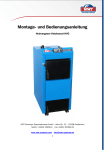
![Bedienungsanleitung '13 [de]](http://vs1.manualzilla.com/store/data/006733181_1-0d51063f398c50c0027ed324afce6269-150x150.png)
